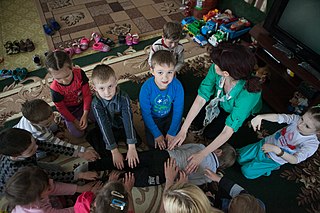
Counseling psychology is a psychological specialty that encompasses research and applied work in several broad domains: counseling process and outcome; supervision and training; career development and counseling; and prevention and health.
Object relations theory is a school of thought in psychoanalytic theory centered around theories of stages of ego development. Its concerns include the relation of the psyche to others in childhood and the exploration of relationships between external people, as well as internal images and the relations found in them. Thinkers of the school maintain that the infant's relationship with the mother primarily determines the formation of its personality in adult life. Particularly, attachment is the bedrock of the development of the self or the psychic organization that creates the sense of identity.
Transference is a phenomenon within psychotherapy in which repetitions of old feelings, old attitudes, old desires, and/or old fantasies that someone displaces, are subconsciously projected onto a here-and-now person. Traditionally, it had solely concerned feelings from a primary relationship during childhood.
Relational psychoanalysis is a school of psychoanalysis in the United States that emphasizes the role of real and imagined relationships with others in mental disorder and psychotherapy. 'Relational psychoanalysis is a relatively new and evolving school of psychoanalytic thought considered by its founders to represent a "paradigm shift" in psychoanalysis'.

Play therapy refers to a range of methods of capitalising on children's natural urge to explore and harnessing it to meet and respond to the developmental and later also their mental health needs. It is also used for forensic or psychological assessment purposes where the individual is too young or too traumatised to give a verbal account of adverse, abusive or potentially criminal circumstances in their life.
Intensive short-term dynamic psychotherapy (ISTDP) is a form of short-term psychotherapy developed through empirical, video-recorded research by Habib Davanloo.
Dyadic developmental psychotherapy is a psychotherapeutic treatment method for families that have children with symptoms of emotional disorders, including complex trauma and disorders of attachment. It was originally developed by Daniel Hughes as an intervention for children whose emotional distress resulted from earlier separation from familiar caregivers. Hughes cites attachment theory and particularly the work of John Bowlby as theoretical motivations for dyadic developmental psychotherapy.
Attachment therapy is a pseudoscientific child mental health intervention intended to treat attachment disorders. It is found primarily in the United States, and much of it is centered in about a dozen clinics in Evergreen, Colorado, where Foster Cline, one of the founders, established his clinic in the 1970s.
Child psychotherapy, or mental health interventions for children have developed varied approaches over the last century. Two distinct historic pathways can be identified for present-day provision in Western Europe and in the United States: one through the Child Guidance Movement, the other stemming from adult psychiatry or psychological medicine, which evolved a separate child psychiatry specialism.
Interpersonal psychotherapy (IPT) is a brief, attachment-focused psychotherapy that centers on resolving interpersonal problems and symptomatic recovery. It is an empirically supported treatment (EST) that follows a highly structured and time-limited approach and is intended to be completed within 12–16 weeks. IPT is based on the principle that relationships and life events impact mood and that the reverse is also true. It was developed by Gerald Klerman and Myrna Weissman for major depression in the 1970s and has since been adapted for other mental disorders. IPT is an empirically validated intervention for depressive disorders, and is more effective when used in combination with psychiatric medications. Along with cognitive behavioral therapy (CBT), IPT is recommended in treatment guidelines as a psychosocial treatment of choice for depression.
Emotionally focused therapy and emotion-focused therapy (EFT) are a family of related approaches to psychotherapy with individuals, couples, or families. EFT approaches include elements of experiential therapy, systemic therapy, and attachment theory. EFT is usually a short-term treatment. EFT approaches are based on the premise that human emotions are connected to human needs, and therefore emotions have an innately adaptive potential that, if activated and worked through, can help people change problematic emotional states and interpersonal relationships. Emotion-focused therapy for individuals was originally known as process-experiential therapy, and it is still sometimes called by that name.
Attachment-based psychotherapy is a psychoanalytic psychotherapy that is informed by attachment theory.
Attachment-based therapy applies to interventions or approaches based on attachment theory, originated by John Bowlby. These range from individual therapeutic approaches to public health programs to interventions specifically designed for foster carers. Although attachment theory has become a major scientific theory of socioemotional development with one of the broadest, deepest research lines in modern psychology, attachment theory has, until recently, been less clinically applied than theories with far less empirical support. This may be partly due to lack of attention paid to clinical application by Bowlby himself and partly due to broader meanings of the word 'attachment' used amongst practitioners. It may also be partly due to the mistaken association of attachment theory with the pseudo-scientific interventions misleadingly known as attachment therapy. The approaches set out below are examples of recent clinical applications of attachment theory by mainstream attachment theorists and clinicians and are aimed at infants or children who have developed or are at risk of developing less desirable, insecure attachment styles or an attachment disorder.
Child psychoanalysis is a sub-field of psychoanalysis which was founded by Anna Freud. Freud used the work of her father Sigmund Freud with certain modifications directed towards the needs of children. Since its inception, child psychoanalysis has grown into a well-known therapeutic technique for children and adolescents.
Robert Joseph Langs was a psychiatrist, psychotherapist, and psychoanalyst. He was the author, co-author, or editor of more than forty books on psychotherapy and human psychology. Over the course of more than fifty years, Langs developed a revised version of psychoanalytic psychotherapy, currently known as the "adaptive paradigm". This is a distinctive model of the mind, and particularly of the mind's unconscious component, significantly different from other forms of psychoanalytic and psychodynamic psychotherapy.

Stan Tatkin, PsyD, MFT, is a clinician, researcher, teacher, and developer of A Psychobiological Approach to Couple Therapy (PACT).
Control mastery theory or CMT is an integrative theory of how psychotherapy works, that draws on psychodynamic, relational and cognitive principles. Originally the theory was developed within a psychoanalytical framework, by psychoanalyst and researcher Joseph Weiss, MD (1924-2004). CMT is also a theory of how the mind operates, with an emphasis of the unconscious, and how psychological problems may develop based on traumatic experiences early in life. The name of the theory comes from two central premises; the assumption that people have control over their mental content, and the belief that patients who come to therapy are fundamentally motivated to master their lives.
Intrapsychic humanism is a comprehensive general psychology and philosophy of mind that provides a new understanding of what it is to be human. Intrapsychic humanism is a nonderivative depth psychology that provides a unified and comprehensive theory of child development, psychopathology, and psychological treatment.
Diana Foșha is a Romanian-American psychologist, known for developing accelerated experiential dynamic psychotherapy (AEDP), and for her work on the psychotherapy of adults suffering the effects of childhood attachment trauma and abuse.
Psychodynamic Therapy with Infants and Parents aims to relieve emotional disturbances within the parent(s), the baby, and/or their interaction, for example, postnatal depression and anxiety, infant distress with breastfeeding and sleep, and attachment disorders. It rests on attachment theory and psychoanalysis. Sigmund Freud suggested that a modification of his method could be applied to children, and child analysis was introduced in the 1920s by [Anna Freud].., [Melanie Klein], and Hermine Hug von Hellmuth. Klein speculated on infantile experiences to understand her patients' disorders but she did not practice PTIP. Donald Winnicott, a pediatrician and analyst, focused on the mother-baby interplay in his theorizing and his brief parent-child consultations, but he did not work with PTIP.